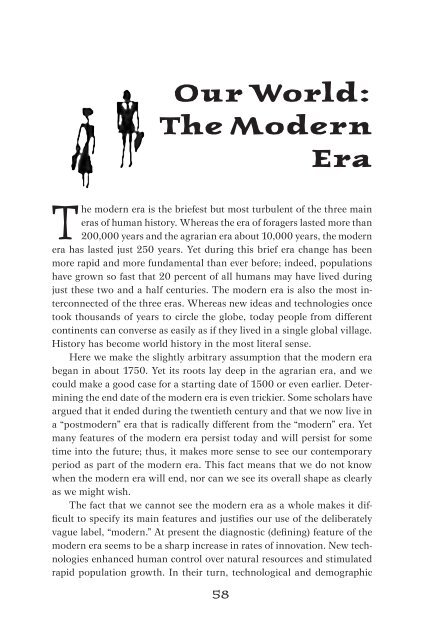This Fleeting World
This Fleeting World
This Fleeting World
You also want an ePaper? Increase the reach of your titles
YUMPU automatically turns print PDFs into web optimized ePapers that Google loves.
Our <strong>World</strong>:<br />
The Modern<br />
Era<br />
The modern era is the briefest but most turbulent of the three main<br />
eras of human history. Whereas the era of foragers lasted more than<br />
200,000 years and the agrarian era about 10,000 years, the modern<br />
era has lasted just 250 years. Yet during this brief era change has been<br />
more rapid and more fundamental than ever before; indeed, populations<br />
have grown so fast that 20 percent of all humans may have lived during<br />
just these two and a half centuries. The modern era is also the most interconnected<br />
of the three eras. Whereas new ideas and technologies once<br />
took thousands of years to circle the globe, today people from different<br />
continents can converse as easily as if they lived in a single global village.<br />
History has become world history in the most literal sense.<br />
Here we make the slightly arbitrary assumption that the modern era<br />
began in about 1750. Yet its roots lay deep in the agrarian era, and we<br />
could make a good case for a starting date of 1500 or even earlier. Determining<br />
the end date of the modern era is even trickier. Some scholars have<br />
argued that it ended during the twentieth century and that we now live in<br />
a “postmodern” era that is radically different from the “modern” era. Yet<br />
many features of the modern era persist today and will persist for some<br />
time into the future; thus, it makes more sense to see our contemporary<br />
period as part of the modern era. <strong>This</strong> fact means that we do not know<br />
when the modern era will end, nor can we see its overall shape as clearly<br />
as we might wish.<br />
The fact that we cannot see the modern era as a whole makes it difficult<br />
to specify its main features and justifies our use of the deliberately<br />
vague label, “modern.” At present the diagnostic (defining) feature of the<br />
modern era seems to be a sharp increase in rates of innovation. New technologies<br />
enhanced human control over natural resources and stimulated<br />
rapid population growth. In their turn, technological and demographic<br />
58


